
Traunstein is a town in the south-eastern part of Bavaria, Germany, and is the administrative center of a much larger district of the same name. The town serves as a local government, retail, health services, transport and educational center for the wider district.
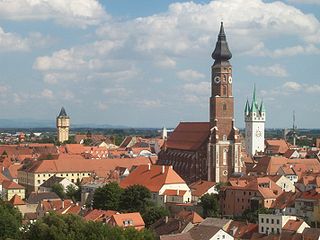
Straubing is an independent city in Lower Bavaria, southern Germany. It is seat of the district of Straubing-Bogen. Annually in August the Gäubodenvolksfest, the second largest fair in Bavaria, is held.

Stadtlohn is a city in western Münsterland in the northwest of North Rhine-Westphalia, and is a district town of the Borken administrative district. The city had a population of 20,746 inhabitants as of 2020. The River Berkel flows through the city on its way to the Netherlands.

Kulmbach is the capital of the district of Kulmbach in Bavaria in Germany. The town, once a stronghold of the Principality of Bayreuth, is renowned for its University of Life Sciences, a branch of the University of Bayreuth, the massive Plassenburg Castle, which houses the largest tin soldier museum in the world, for its brewery, its vivid food industry, which hosts some of the world's biggest food businesses, and for its sausages, or Bratwürste.

Tangermünde is a historic town on the Elbe River in the district of Stendal, in the northeastern part of Saxony-Anhalt, Germany. The town has land area of around 89.87 sq.km and a population of 10,283 people as of 2022.

Marienberg Fortress is a prominent landmark on the left bank of the Main river in Würzburg, in the Franconia region of Bavaria, Germany. It is a symbol of Würzburg and served as a home of the local prince-bishops for nearly five centuries. It has been a fort since ancient times, although most of the current structures were built in Renaissance and Baroque styles between the 16th and 18th centuries. After Gustavus Adolphus of Sweden conquered the area in 1631 during the Thirty Years' War, the castle was reconstructed as a Baroque residence. After it ceased to serve as residence of the Bishops of Würzburg, the fortress saw repeated action in the wars of the late 18th and 19th centuries. It was severely damaged by British bombs in March 1945 and only fully rebuilt in 1990. Today, it houses two museums.

Rothenburg ob der Tauber is a town in the district of Ansbach of Mittelfranken, the Franconia region of Bavaria, Germany. It is well known for its well-preserved medieval old town, a destination for tourists from around the world. It is part of the popular Romantic Road through southern Germany. Today it is one of only four towns in Germany that still have completely intact city walls, the other three being Nördlingen, Dinkelsbühl and Berching, all in Bavaria.

Homberg is a small town in the northern part of Hesse, a state in central Germany, with about 15,000 inhabitants. It is the seat of the Schwalm-Eder district. In 2008, the town hosted the 48th Hessentag state festival.

Klingenberg am Main is a town in the Miltenberg district in the Regierungsbezirk of Lower Franconia (Unterfranken) in Bavaria, Germany. It has a population of around 6,200 and is located on both banks of the river Main.

The Alter Hof in the center of Munich is the former imperial residence of Louis IV, Holy Roman Emperor and consists of five wings: Burgstock, Zwingerstock, Lorenzistock, Pfisterstock and Brunnenstock. Like most of the old town, it was rebuilt after being destroyed in World War II.

Bergstadt Lößnitz, sometimes also called Muhme (“Aunt”) for its age, is a town in the district of Erzgebirgskreis, Saxony, Germany, and belongs to the Town League of Silberberg. Its name comes from the Slavic lesnice, meaning “forest place”.
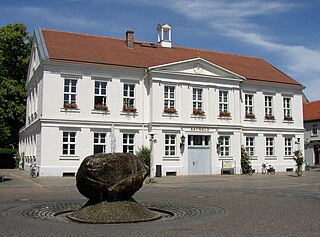
Pritzwalk is a town in the district of Prignitz, in Brandenburg, Germany. It is situated 20 km west of Wittstock, and 33 km northeast of Wittenberge. The river Dömnitz flows through Pritzwalk.

Greding is a town in the district of Roth, in Bavaria, Germany. It is situated 28 km southeast of Roth bei Nürnberg and 32 km north of Ingolstadt.
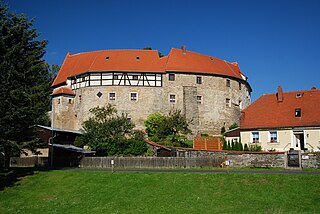
Waldershof is a town in the district of Tirschenreuth, in Bavaria, Germany. It is situated 22 km northwest of Tirschenreuth, and 3 km southwest of Marktredwitz.

The New Town Hall is a town hall that forms the northern part of Marienplatz in Munich, Bavaria, Germany. It hosts the city government including the city council, offices of the mayors and a small portion of the administration. In 1874 the municipality had left the Old Town Hall for its new domicile.
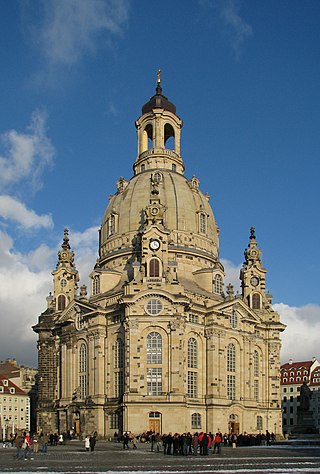
Reconstruction in architectural conservation is the returning of a place to a known earlier state by the introduction of new materials. It is related to the architectural concepts of restoration and preservation, wherein the most extensive form of reconstruction is creating a replica of a destroyed building.

The Historical City Hall of Münster, located in the centre of Prinzipalmarkt 10, is a well-known and much-visited landmark of the city of Münster, alongside Münster Cathedral, with over 120,000 visitors recorded at the site in 2012. It rose to prominence during the negotiations for the Peace of Westphalia Treaty of 1648, which concluded the Thirty Years' War in Western Europe; and the Eighty Years' War between Spain and the Republic of the Seven United Netherlands.
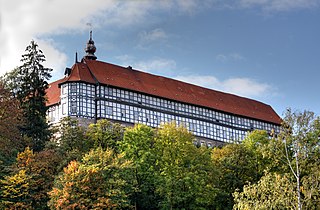
Herzberg Castle is a German schloss in Herzberg am Harz in the district of Göttingen in the state of Lower Saxony. The present-day, quadrangular building has its origins in the 11th century as a medieval castle. After a fire in 1510 it was rebuilt as a schloss and is one of the few in Lower Saxony that was constructed as a timber-framed building. Because it belonged to the House of Welf for 700 years it is also known as the Welf Castle of Herzberg.

Würzburg is, after Nuremberg and Fürth, the third-largest city in Franconia located in the north of Bavaria. Würzburg is the administrative seat of the Regierungsbezirk Lower Franconia. It spans the banks of the Main river.

Hutschenreuther is the name of a German family that established the production of porcelain in northern Bavaria, starting in 1814.



















